METANOIA: The art project that wants you to unzip your skin
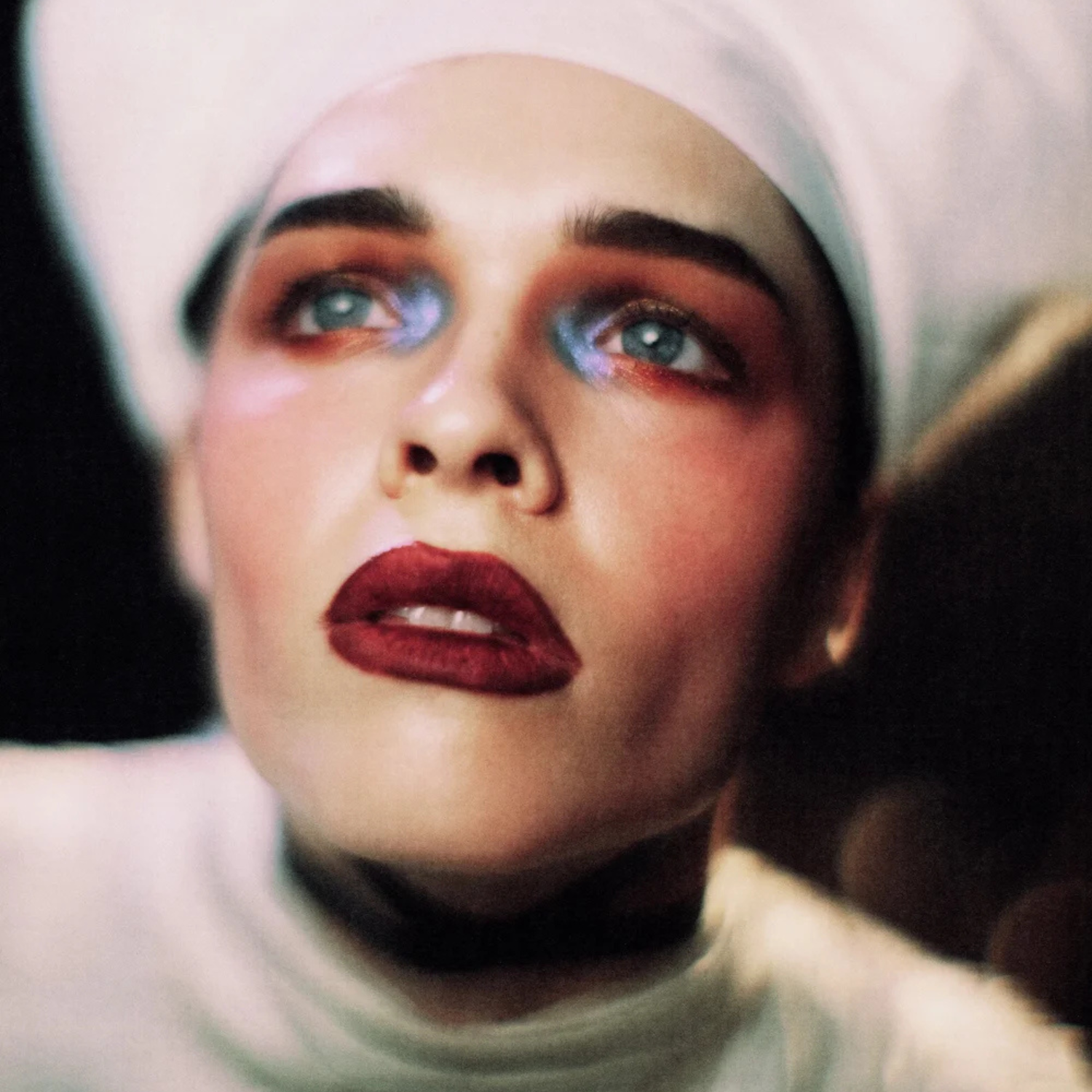
METANOIA’s story arc is fashioned into four stages of transformation. We begin in “The Womb”, where the seeds of fear are planted, slowly consuming your every thought. Then, we are jolted into “The Urge”, a world of red velvet-cloaked walls where the monstrous dwells in temptation. “Giving In” is laid bare on a dinner table, sheer and vulnerable, before the “Final Transformation” sees a coexistence of opposites, where power is discarded and the lines between the monstrous and reality are permanently blurred.
It is in this Gothic liminal space that actors David Dastmalchian and Sedona Legge metamorphose into something inhuman: he, a clockmaker trapped in his own mind and she, a demonic-angel hybrid set to free him. They enact a story of enticement, exploring the liberation that can be achieved when we confront the darkest depths of ourselves. Bound in a world that entangles high fashion and horror, METANOIA reminds us of the beauty found in pain. Intended to be a photo series from the mind of photographer Gina Manning, the concept begged to come to life on film. Working with director Mike Pecci, the pair orchestrated an exorcism of the terrified self, posing the question: Who are we, without our shadow selves?
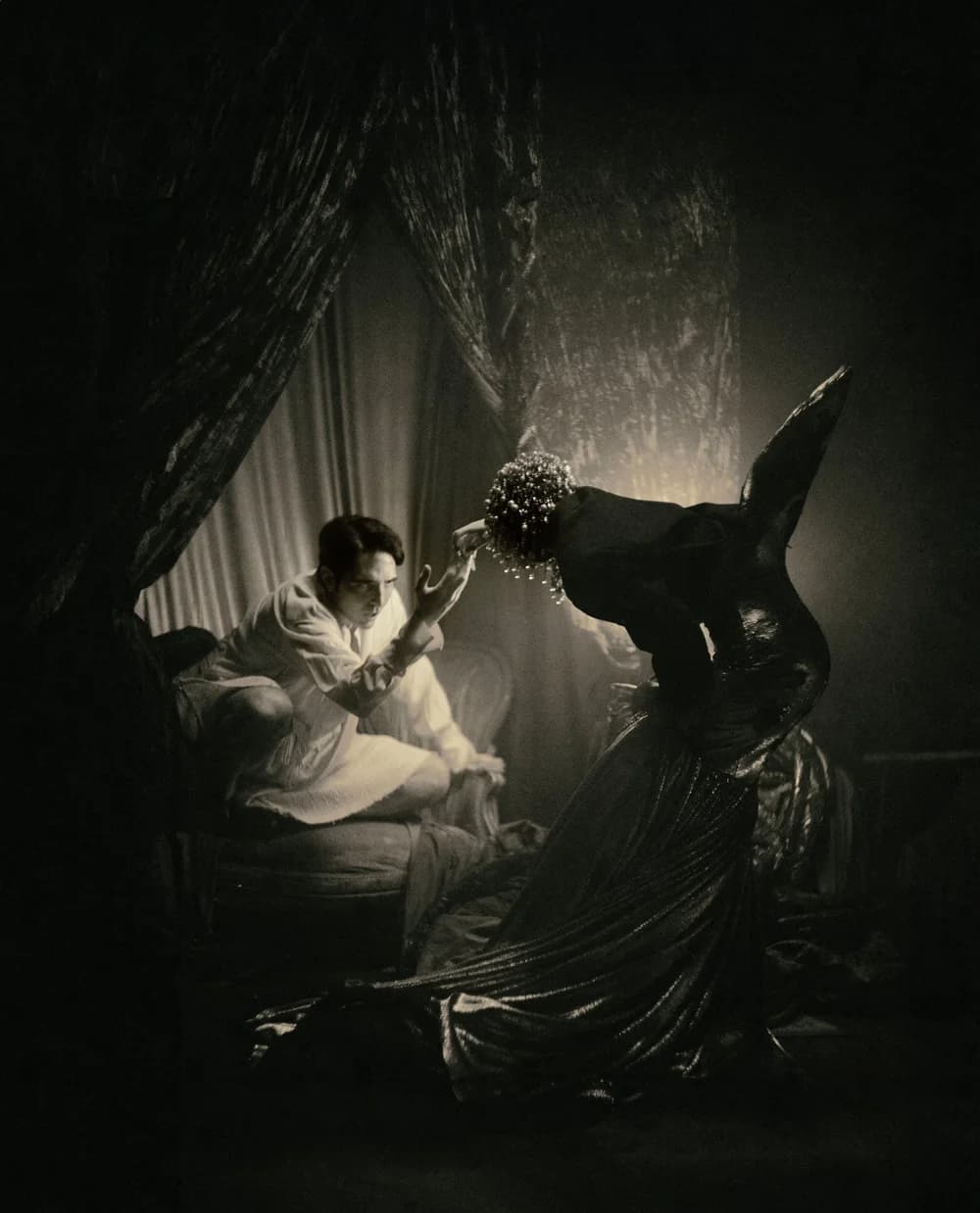
Paulina Subia: Gina, I would love to hear more about how you and David first met and what led to the project’s initial concept.
Gina Manning: [David and I] immediately got deep on life, chatting about everything: fears, shame, happiness, where we want to be and what we’d like to see next. I went back home and… came up with the beginning of this idea. When the crew, Sedona [Legge] and Mike [Pecci] got involved, it kept growing. [Initially], it was supposed to be this amazing photo shoot. I was in a phase (and I guess I always am) where there’s the work I do for money and a lot of the time, I get to make that a passion. But sometimes, I just want to make something that isn’t controlled by any funding and is completely independent. We planned for about a year, but even on set, we still did whatever we felt was right, and that went for each artist who was involved, which was really special.
David Dastmalchian: I was really impressed with the way Gina’s photography was able to capture different sides of people and offer a highly stylised, yet still authentic, revelation of vulnerabilities that I always find myself wanting to do, but get nervous about. I’ve done a lot of really cool shoots and had really positive experiences, but I wanted to explore a different side of myself. I wanted to see how the two sides of my coin — my shadow self and my self-self — are ever-present in the spectrum that makes up who I am as a human being. The truth is, to me, it’s like a snake eating its own tail. I’m scared of the world and of myself, but then I can feel scary and the world can, too, and that fuels the fear that I feel. [I said to Gina], Whatever the fuck that means to you as an artist and photographer, I would love to just see what happens.

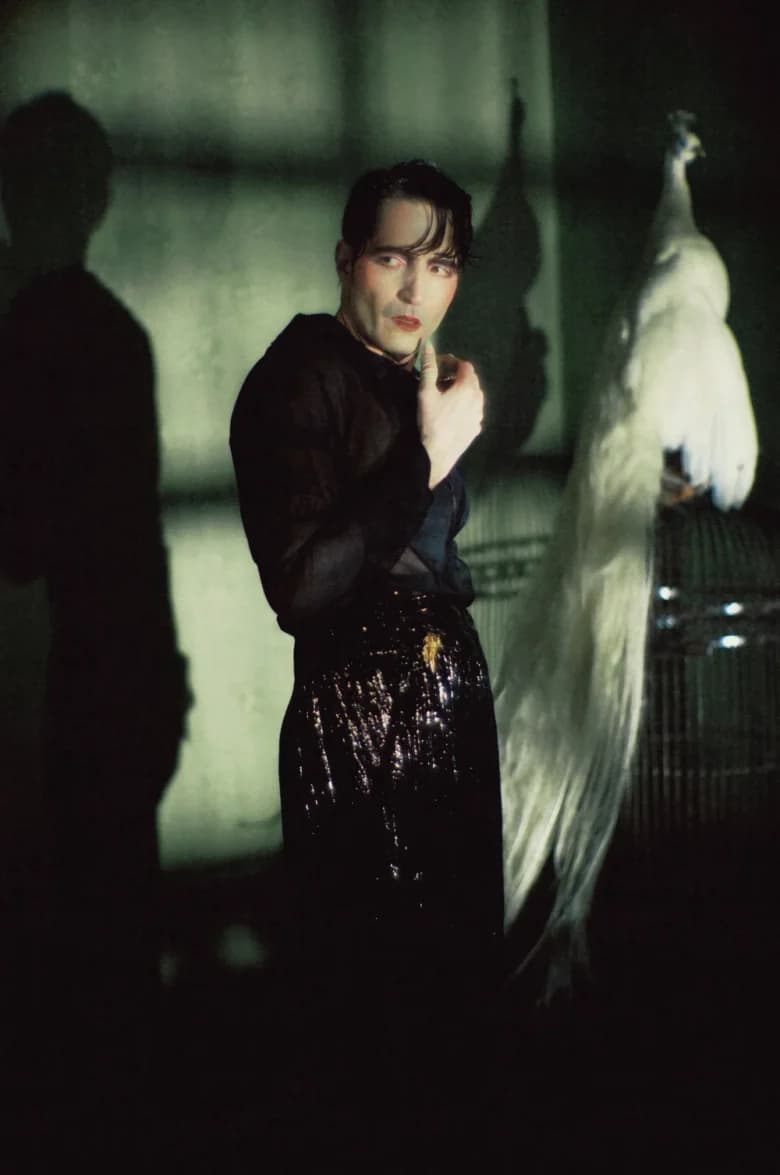
PS: Sedona and Mike, what initially drew you both to join the project?
Sedona Legge: Gina reached out to me on Instagram and I thought it was just going to be a photo shoot at first. Then, David and I had such good chemistry on set. It was so natural. I was riffing off of how he was feeling and he was riffing off of how I was feeling, and it turned into this beautiful film.
Mike Pecci: Gina and I are together, so we’ve been working together on and off for years. When Gina was [planning] this project, I would look over her shoulder at her worlds — I’ve always been in awe of the worlds that Gina creates through all of her design and taste. I was like, Man, this is some really cool stuff. And she said, You know, there’s room to make a little film in here. Would you want to do a film? I said, I’ll only do this if this is your world: you design everything. Then, I’ll come in and make a little piece in your space.
It was a treat because I got to walk into such an overly saturated world. I got to meet David for the first time and it was a great opportunity for discovery. I think that this entire piece has told us what it wants to be, and has continued to grow and become something more.
As we put this thing out and people see the film aspect of it, we’ve been getting such great responses from people because of David. I mean, you turn the camera on David [and] you just watch him do his thing — I just got out of his way for most of it. Then with Sedona, it was such a surprise. [During filming], David had commented on [her performance] and I was like, Oh shit, she’s crushing this thing! We ended up really opening this up and making it into the piece that it became.
GM: The chain mail [worn by Sedona] in the piece, Sedona [made] herself and it’s just so incredible. There was this one scene we had with the shadow play, where [Mike and I asked], Sedona, would you stay and wear that piece? That was something that came together on set, which is so crazy. The light makeup and all-chain mail were so beautiful. I think that’s probably my favourite of all the sets, the final transformation.
SL: That full chain main piece is one of the first pieces I’ve ever made. I was working as Tom Ford’s muse model at the time and got to see his whole design process from start to finish. I’m quite a perfectionist in everything that I do and I thought, I could never do that. Then I saw how free he was with his process, taking away control — he just kind of went for it and that was really inspiring. In the fashion district in Los Angeles, I picked up a bunch of random things that inspired me and started experimenting with chains and glass beads. I’m really good with a pair of pliers because I hand-make every single bead, every link. That’s why my hands are so messed up!

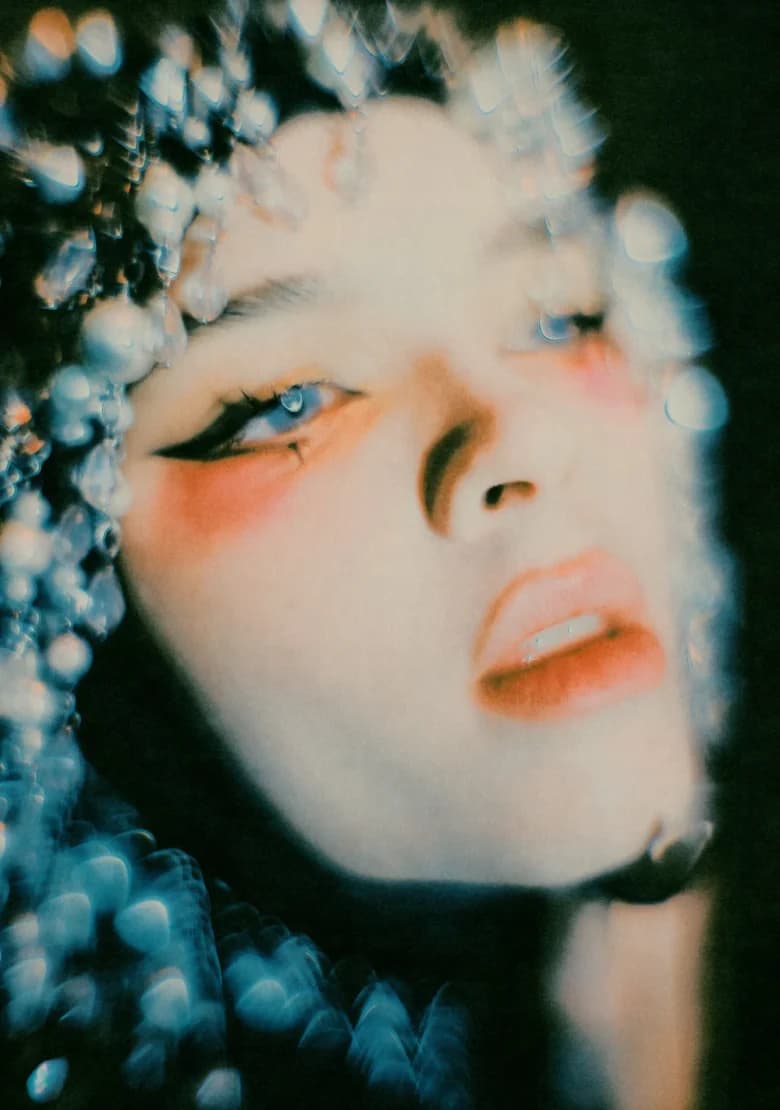
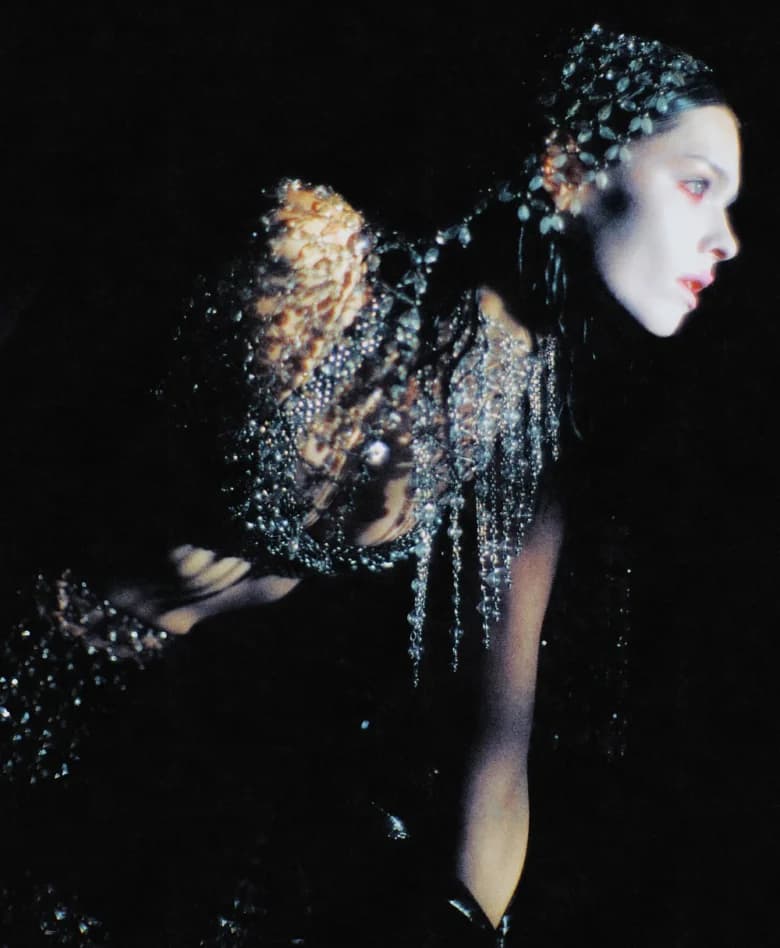
PS: That’s so impressive. The chain-mail looks so gorgeous on film, too. The way it contorts as your body moves is incredible.
SL: Thank you. That’s kind of why I make what I make. Whether for celebrities or film, I want the piece to glisten when light hits it. My pieces are very performative, in a sense.
PS: The shadow work is so evocative throughout the whole project, and Mike, I loved your style of directing. The quick cuts feel very dreamlike, kind of nightmarish but also beautiful at the same time. I’m wondering how much of that was intentional and how much came naturally?
MP: With a piece like this, there’s no script. David, Gina and I spoke about the emotional transition that we thought his character should go through. Then, it was just unleashing both of them and finding it. The edit on this was very difficult because it went from being a cool video supplement to actually looking at this footage and going, This is incredibly special and there’s something really great about this. It was the process of us sorting through [and] becoming very imaginative about what we could do with the footage, and how we could expand the world.
GM: We were definitely able to build the story once we were looking at the footage, which was really awesome.
MP: The foundation was there, in all of Gina’s hard work, [as well as] David and Sedona’s, and it actually put pressure on me, as a filmmaker, to go, Oh shit, this needs to be more than what we were intending. Then, it was just trying to live up to those standards.
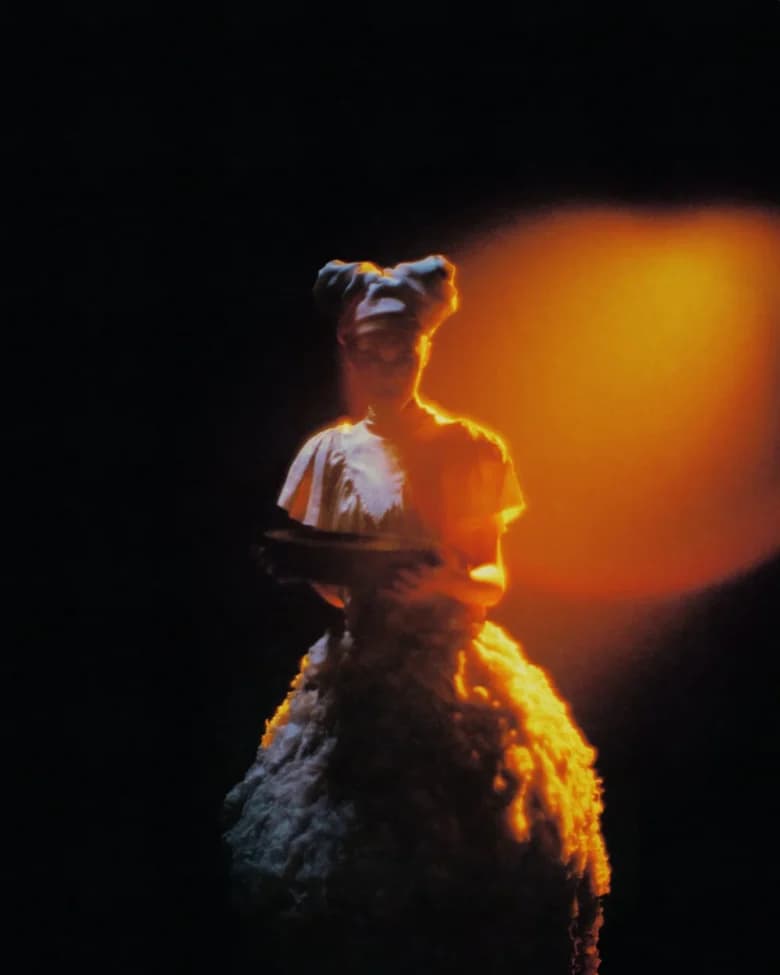

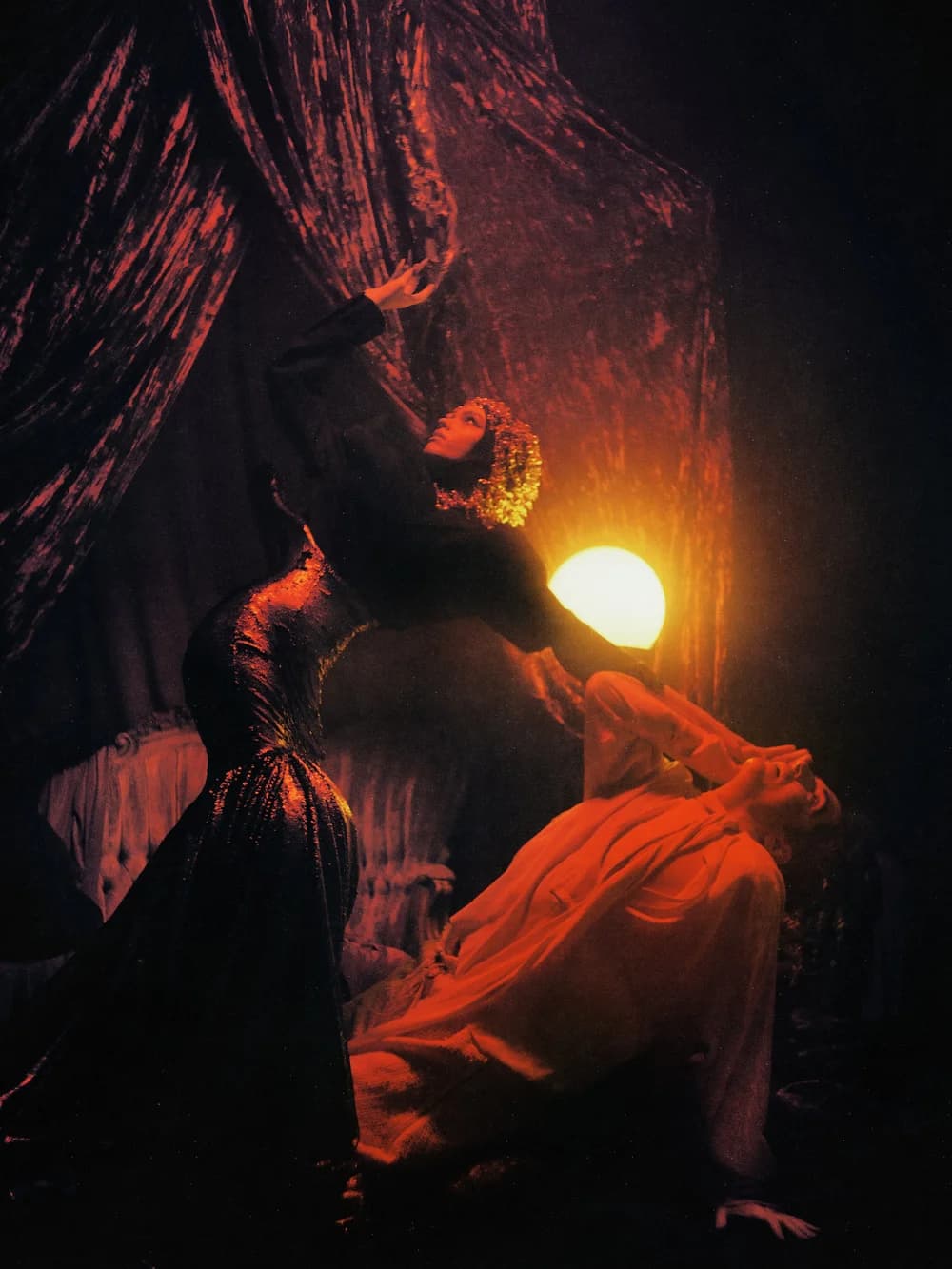
PS: David and Sedona, what was the challenge in the lack of dialogue? I’d imagine it’s kind of like navigating its own language.
SL: For my character in particular, the subtlety is where she has her power. Her silence is her power, in a sense, and it’s hypnotic. For me, the eyes are always what tell the story. It was super natural and David is amazing to work off of.
DD: No, it was all you, Sedona! The world that Gina had imagined — the sets that were built for us, the makeup, the styling — was so particular. The designs, which shifted so much with the hair and makeup, [led to] the evolution of myself throughout the shoot.
Because there are these four stages of primordial evolution throughout, I was like, What do I latch on to here? This wasn’t like ‘acting’. There was no text, scene work or blocking. It’s an experience. This was a really weird and wonderful space, [and] an opportunity for me to breathe deeply to try and get as relaxed as possible, so that I could experience these uncomfortable, emotional states that I’d been going through in my personal life. We did this shoot on the heels of probably the worst five months of my life, by far. I was like, Okay, how do we breathe and get in there, so I can just allow myself to be?
And then here comes [Sedona as] this ethereal, terrifying, powerful, weird, childlike figure that is also ancient at the same time. It was so bizarre. We didn’t know one another, so it’s always an odd thing [of], Hi, how are you? Now we’re going to go on a cosmic, psychological, spiritual odyssey together.
I give Gina so much credit because she just kind of stepped back and focused more on capturing it, [rather] than dictating it, which was really special. So then, I found my slingshot, if you will, and then just kept injecting that energy. Every time I’d feel myself slipping out of it, or starting to think about the stress of whatever bullshit I was trying to understand about my life falling apart at that moment, I could just fall apart in that weird space in some warehouse studio in the Valley.
MP: We spent a lot of time and energy crafting a playlist to make sure that we kept [David and Sedona] in that mode and mood.
SL: That really helped, too. Music is such a big trigger for me, in general.
MP: We knew it was working because we’d watch [Sedona’s] performances, then look at the monitors and [see] the whole beauty team just bawling their eyes out. In post production, Gina’s main thing to me in the edit was, ‘Just make them feel like we felt on set.’

PS: What was on the playlist? I’d love to know.
GM: We had four separate playlists.
DD: I’ll never forget when you were pulling up Bram Stoker’s Dracula score when we were [filming] the shadow work. I also feel like in some of the play spaces, it was Rachel’s or Deftones? I was just swimming in it.
MP: It was everything from [the scores to] Beyond the Black Rainbow and the original Blade Runner, to Vangelis’ stuff. It was all over the place and fun. The stuff that David was going through is completely in his character and his movements, and the stuff that we were going through is all in this piece. When you watch it, it feels so emotionally saturated with everybody’s experience, all the way through.
GM: It is this beautiful cross-genre. There aren’t many things that can fit a horror outlet, but also be in a high fashion outlet. That was the beautiful thing about bringing all of my friends from the fashion world and [Mike] bringing all of [his] friends from the film and horror world.

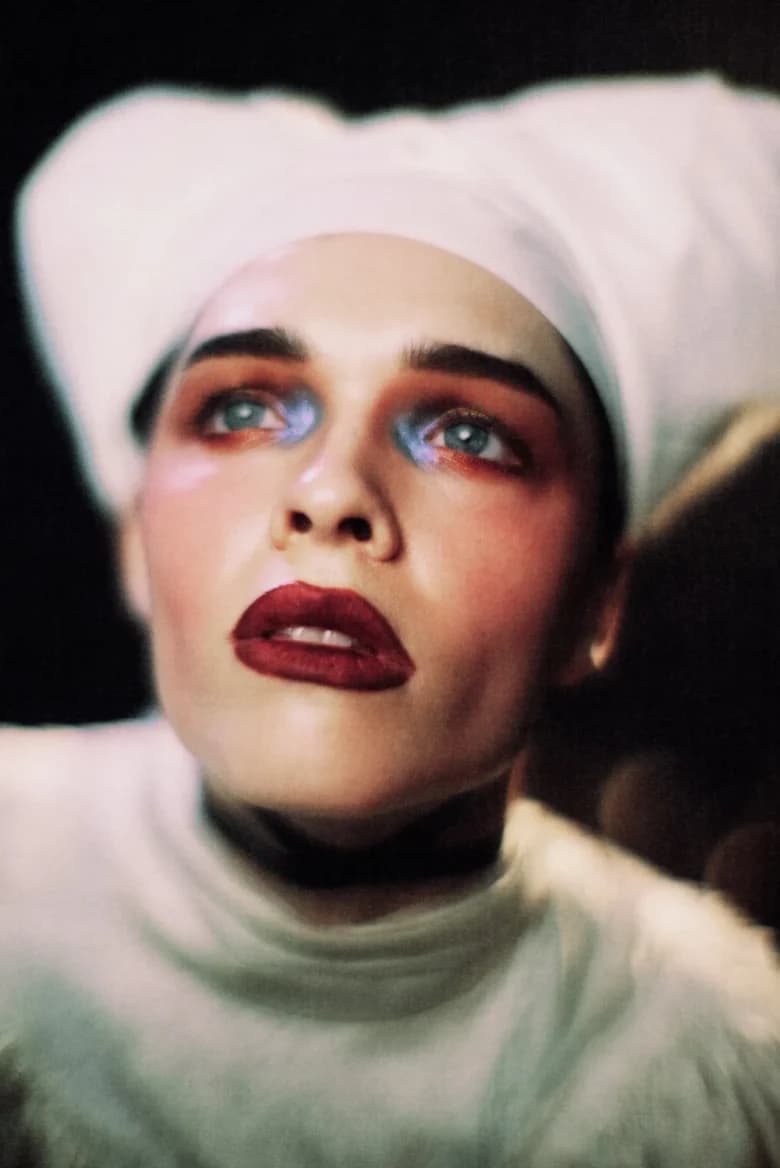
PS: Elements of the Gothic pervade the whole project. How did the genre and aesthetic inform its initial concept?
SL: They saw me and were like, We have to go in that direction. [Laughs]
GM: Ironically, I think I’m maybe the least Gothic of all four of these guys! David definitely brought that — he is a human embodiment, just so obsessed. I was excited to bring my fashion into his horror element. Then, with Mike being a horror director, as well…
MP: …There was just so much to pull from. [Robert] Eggers released Nosferatu and now, we’re super excited about Guillermo del Toro releasing Frankenstein. There’s all this really great Gothic horror that’s coming back and, if you go further back into the ’90s with movies like The Crow and Dark City, they have always somehow had really amazing, trend-setting fashion in them.
PS: To your point, Gina, even if you’re not a ‘goth’ or don’t even like horror, there are those elements in both the film and the photos that everyone can resonate with. I think it goes back to that overarching idea of the ‘monstrous’ and what we’re repressing: it’s always something that you can pull from and relate to, and speaks to how universal the project is.
SL: Also, finding the beauty in the darkness.
GM: Even down to set design, we wanted to create a world that kind of got stripped. We went from the first set that was built on a soundstage studio, where nothing was real, to taking out all of the things that made it a ‘house’ and just having the table.
SL: Every time I went on set, it was a new environment and I was so blown away.
PS: Thinking of how the project was actually shot, both on film and photographed, it looks so cinematic and high quality, yet also has a dreamy film cast over it.
GM: This was funded partially by our friends at Black Magic, so we shot it all on Black Magic cameras, which was really fun.
MP: We work with Black Magic a lot in the film world. But when you’re in the fashion world, it’s often still photography equipment and gear. We shot on this 6K, large-format camera, which enabled us to shoot through real cinema glass. Then, we got special lens adapters so that Gina could strap those cinema lenses onto her Fujifilm cameras. The byproduct was that both formats were affecting each other: the way she was shooting her photos was affecting the way we would light, etc.

PS: I’d love to talk about the fashion. Gina, what was the process like for you, whether it was sourcing costumes or getting them made? Did you work off a moodboard?
GM: We worked with my friend, Keyan Miao. Everything was couture, high fashion, or made by Sedona, which is awesome. For me, breaking it down into four worlds was really fun because what everyone was wearing was specific to the emotional tone. The third transformation was super vulnerable, so David had on this sheer shirt where you could actually see his skin underneath, but it still had texture. In the final transformation, where Sedona was supposed to be the most vulnerable, there was something so special about her wearing chain mail, which protects you, but…
SL: It’s also kind of naked, at the same time. There’s the vulnerability there.
MP: What about the bird-like dress at the table sequence?
GM: There was almost a nurse, mother-y feel to [Sedona’s] character at that point, whereas David was just giving in to everything. I really wanted that to be a big outfit, and Keyan found this designer and showed me the dress, and I was like, You don’t even need to bring any other options. That’s the one.
MP: As we progressed and got into the whole ‘white peacock’ thing, that dress ended up becoming such a symbolic thing for Sedona’s transformation. That was accidental.
GM: When everybody involved loves [the concept] so much and understands it to such a deep level — not because they have to, for any other reason — that allows people to be fearless.
MP: David’s first outfit, the suit he wore, was reminiscent of an old military outfit, very steampunk. That broach that he had on is my favourite. That whole sequence felt very [similar to] Guillermo del Toro.
GM: It was really fun to explore going from a super strong look to getting more and more vulnerable. I was inspired by this old Prada runway show [Fall 2012, Milan Fashion Week], where all the villains in movies came out wearing the most gorgeous looks.
MP: That was our initial conversation, where I was like, I’m fascinated with the idea of how Nosferatu can become Nosferatu, how a character can go from his normal, mundane life and have an idea, which can transform him at such a level. The transformation that happened in the wardrobe was so cool.
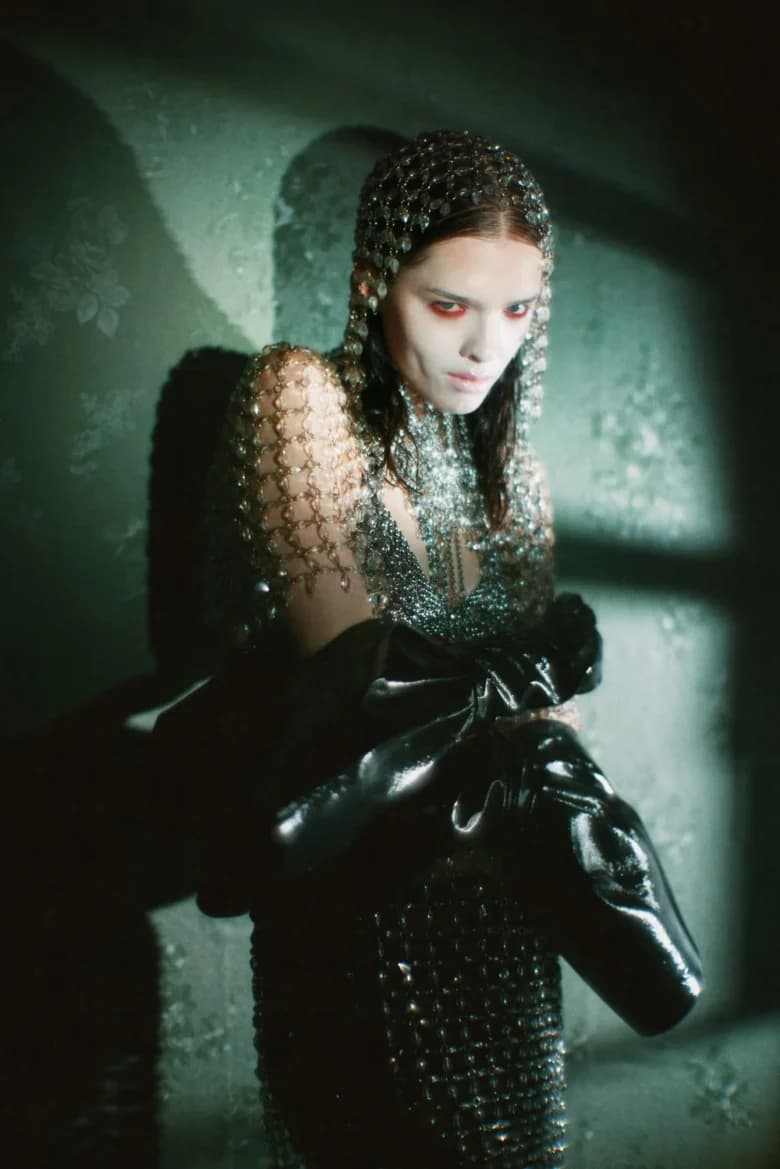

DD: Going back to my first look, it was very emblematic of what the journey felt like for me. It was interesting that the prop that I was given to interact with was a clock. I was putting this clock together, controlling this mechanism, this time, and the uniformity of that particular look, with the hair and the rigidity of the way that Gina was putting me in the space, [resembled] a man in control.
Personally, thinking about how the whole shoot went, what was fascinating was that I have absolutely struggled in my mental health with being a compulsive, controlling, manic individual. I recognised that you can’t control the clock or make it do what you want. You’re not in control of the things or the people that are around you as much as you wish you could be, because it would make the world much safer or more dependable.
That came unwound [for me] and then, out of the back corner of this space comes what seems like a chaos demon, an ancient spirit, a figure from timelessness, that is going to take and dismantle all of this man’s sense of false security around this idea of control.
SL: [Laughing] Which is what I do on a daily basis.
DD: You’re doing the Lord’s work, Sedona! You came creeping over [and] your body control was so fascinating. The best stuff that we got, I think, was when it felt like there was no one there and like we were evaporating into our subconscious soup.
I look at those images and see myself projecting an illusion of composure, control, power and order, which I think I’ve tried to do for most of my life. Until I realised that, when you get into enough psychic 20-car pileups, that’s not actually how this shit works. Then, from there, [you] plunge into the complete vulnerability of being born again, at the mercy of powerlessness. In that, something is being born in you that is much more powerful, animal and beautiful.
That version of me with the fingers [on film] is who lives inside of me; he just doesn’t get to be out. It was nice that, for that day, he got to be completely out in the world. Who gets to fully unzip all of their skin and bones like we got to do? You don’t get to do that very often.
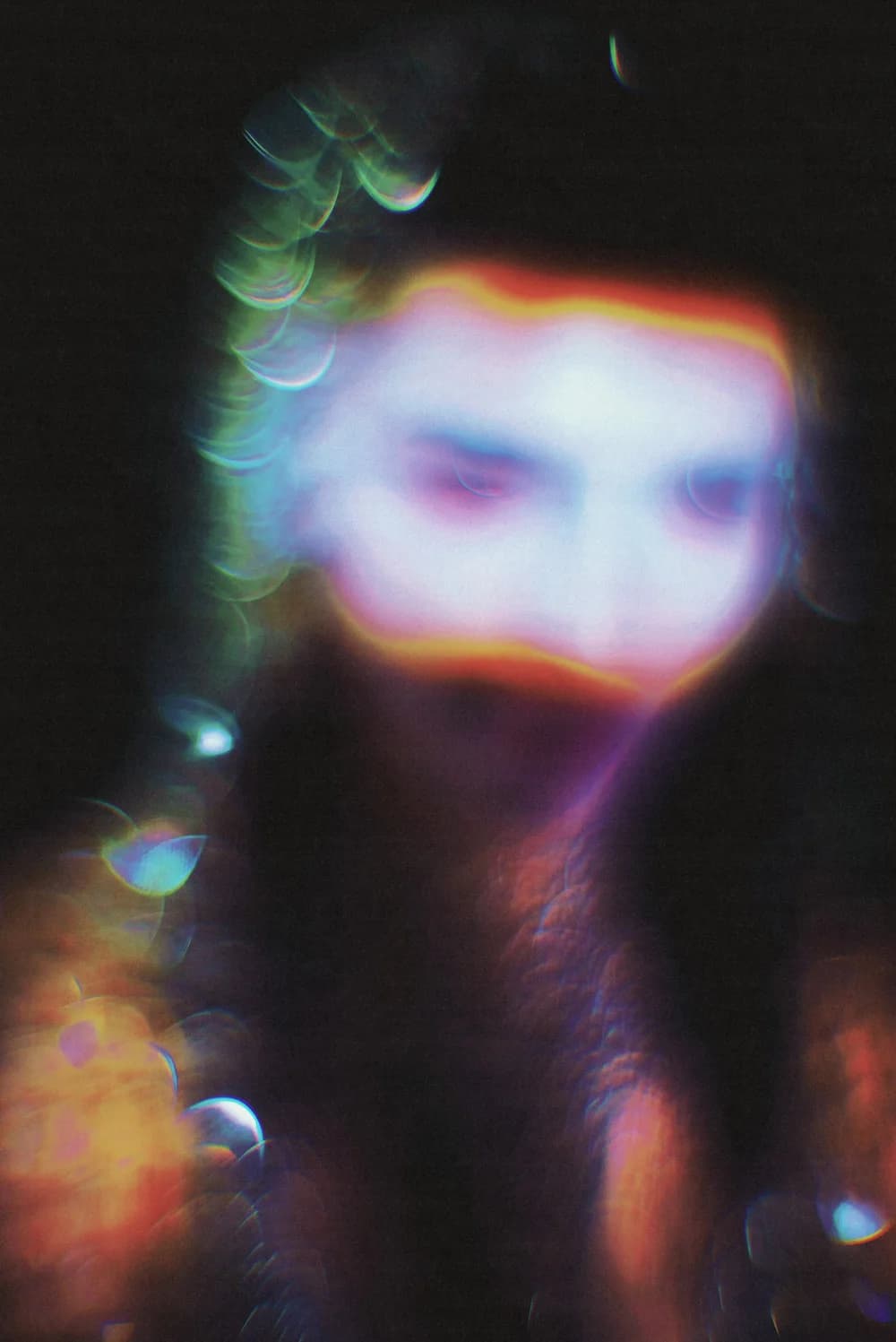
PS: From a cathartic perspective, what was something that the film helped you emulate, whether on-screen or behind the scenes, and how did it help you each to explore something you fear?
DD: For me, it was about releasing control, taking a plunge into powerlessness and accepting the inevitability of what is so horrifying and beautiful that is sleeping inside of ourselves.
SL: For me, it was a bit of the opposite; it was taking control. There was this feminine power in the subtlety of my movements and silence, and how powerful that was on David. It was more of me finding control in the world.
GM: I can’t get past this one thought, which is, I have this insane imposter syndrome with everything I create, so I’m always trying to make the biggest thing I can. There was a moment on the second day [of the shoot] where I was freaking out for no reason. It was going so well, but [I was] just afraid. I’m always doing exactly what I want to do when I create, but I spent many years trying to change it, thinking, What if this isn’t marketable or profitable? So, I’m always trying to do the most extreme version of what I want, to hide my own self-sabotage of creating freely.
MP: This is a weird project for me because normally, as a director, you come into this game in charge of everything, and you know exactly what’s going on. The value of this relationship is that I really gave up a lot. Then, when you get into the editing room, you’re confronted with all of this footage that is beautiful and all over the place. It is a very daunting thing to sit in front of this footage that had amazing performances, but wasn’t traditionally structured in any way. It was an emotional rollercoaster — letting go of ego and fear, I think.
GM: That’s funny, it seems like it was more of Sedona and me taking control, and you guys letting go of stuff.
DD: That’s kind of fucking awesome. With thousands of years of paradigms, it’s time to shift some shit around. I love that.
Watch the teaser video here and learn more about METANOIA here.
- Creative Director and PhotographerGina Gizella Manning
- StarsDavid Dastmalchian, Sedona Legge
- Article WriterPaulina Subia
- DirectorMike Pecci
- Production CompanyGIZELLA
- ProducerMike Tran
- CinematographerDavid Kruta
- Production DesignerAlen Stubbs
- StylistKeyan Miao
- Make-Up ArtistsLeilani Sunglao, Alexandra French
- Hair StylistHeather Lurk
- Nail ArtistsChristina Guerra, Justine Fang
- Special Effects ArtistAna Victoria Esquivel Vasquez
- Videographer's AssistantsZiggy Jaz Van Koeverden, Kyle Stubbs
- Photographer's AssistantKirt Barnett
- Digital Imaging TechniciansDante Velasquez Jr., Zachary Smith
- GafferJames Swartz
- ElectriciansNicholas Brazzill, Isaac Izard, Adam Silva
- Lighting TechnicianTopher Hammond
- Set Design AssistantsAidenHansen, Rey Zane, Faisal Chaarawi
- Production AssistantLance A. Williams
- LocationCinepacks Studios

